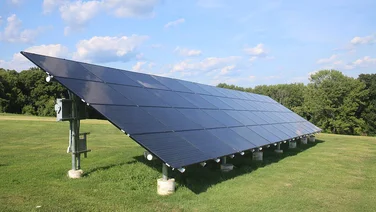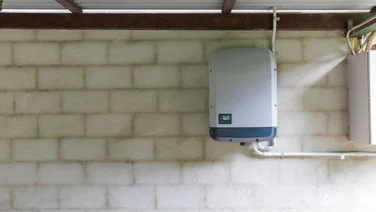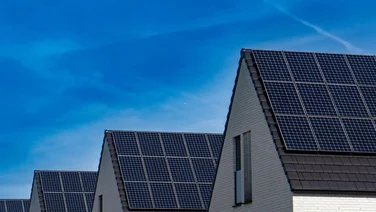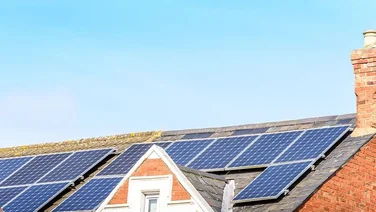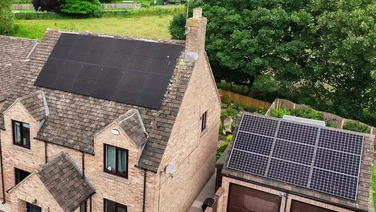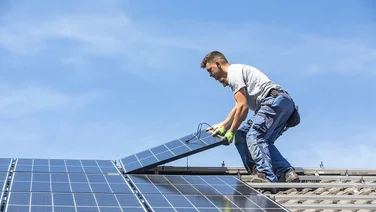- Solar inverters convert solar panel electricity so it can be used in your home
- A standard string inverter will typically cost £500-£1,000
- Microinverters usually cost £100-150 per unit
The beating heart of any solar panel system is the inverter, as the solar panels’ power output is dependent on it. They may add to the cost of solar panels, but a panel or two can stop working and the rest of them will keep going. If the inverter breaks, the whole system goes kaput.
On this page, we’ll tell you all you need to know about solar inverters, including how they work, what size you need, and how much they cost.
Haven’t yet made the switch to solar? We can help. Simply pop your details into this form, and we’ll connect you with local installers who’ll provide you with free quotes to compare.
Where do you want to install solar panels?
Get started
What is a solar inverter?
In a solar PV system, a solar inverter (or solar panel inverter) is essentially the gateway between your panels and your home. Any electricity that your panels generate must pass through this corridor before it can be used to power your premises.
But what’s the point of this middle man? Well, solar panels create direct current (DC) electricity, whereas the majority of home appliances need alternating current (AC) electricity. The inverter transforms all DC electricity into AC electricity.
Without an inverter, your solar panels are just useless plates of silicon.
What else does an inverter do?
Alongside crucial AC/DC conversion, most solar inverters also offer some kind of monitoring, typically via an app. This means you can keep an eye on how much electricity your panels are producing, and spot any faults with the system.
Over time, this will give you a sense of when your solar panels’ electricity production is highest – which is when you should be carrying out most of your daily electricity usage. Although, this is easier said than done, we admit.
How efficient is a solar inverter?
A typical solar inverter is around 95-98% efficient, meaning it loses around 2-5% of the electricity it converts. This is understandable, as an inverter needs to use some of the electricity to power itself.
When you compare this with a typical solar panel’s efficiency (usually around the 15-20% mark), solar inverters seriously outperform their flatter teammates.
Can solar panels work without one?
No, even the best solar panels on the market cannot do anything without an inverter. It’s as simple as that.
Want to get a better idea of what it’s like to own a set of solar panels? Check out our case study with Andrew, based in North Yorkshire.
Andrew had a 3.95 kWh solar panel system installed in June 2022, which cost roughly £6,000. Despite electricity prices increasing around the world, Andrew’s panels are already saving him £32.93 on energy bills. He’s also projected to save around a tonne of CO2 a year with his panels.
Check out the full interview with Andrew to learn more about solar panels.
Where do you want to install solar panels?
Get startedHow much does a solar inverter cost?
If you’re getting a standard string inverter for residential solar panels, the cost will typically range from £500 to £1,000, depending on the size of your system.
Meanwhile, microinverters typically cost around £100-150 per unit.
Power optimisers typically cost £40 each, but need an inverter costing around £600 as well.
So if you had a 3.5 kW solar PV system comprised of 10 350W panels, you’d need to spend either £1,000-1,500 for 10 microinverters, or £1,000 for £400 worth of optimisers and a £600 inverter.
The first time you buy solar panels for your home, the inverter will come as part of the purchase and installation. This means that any solar panel quotes you receive will include the cost of the inverter – so no need to worry about adding on any extras.
Want to find out how much solar panel systems cost before investing in one? Head to our Solar Panel Cost page for more information.
Types of solar panel inverter
There are three different kinds of solar inverter that you can use with your solar panels. As is the case with any sensible industry, you get what you pay for.
String inverters
A string inverter (or centralized inverter) is the cheapest of the three options. It functions as a lone operator, processing the DC electricity of all your solar panels. Usually up to 14 panels are wired together in a ‘string’ (this is a figurative term), sending all their electricity to one inverter.
And yes, as you may have guessed, this gives the string inverter a lot to do. All your panels are essentially working together as one big unit, and all their output is flowing through the same box (normally located in a loft or garage).
The main advantages? More affordable than microinverters, and fairly easy to maintain due to a single, accessible location.
The main disadvantages? With a string inverter, your solar PV system is only as effective as its weakest point. If one panel is affected by a bit of tree shading and its output drops, the output of your entire system will fall to that level. This sounds like a fairly huge disadvantage, but if you keep all your panels out of the shade then this will never be an issue.
Microinverters
If a string inverter is like one big independent bear, microinverters are like a pack of small wolves. Although more expensive (costs are detailed below), they work together to get much more out of a solar PV system.
Crucially, there’s one microinverter per panel, meaning that each solar panel’s DC electricity is converted separately from another panel’s DC electricity. The merging of each panel’s electricity only takes place once it has been converted into AC.
The main advantages? Most importantly, your high-performance panels aren’t held back by the bad ones. If a solar panel is affected by shading, or its microinverter is having issues, everything else will just crack on. Also, you’re able to monitor the performance of each panel, and quickly identify any faults.
The main disadvantages? The higher cost is obviously the main setback, but if your solar PV system is sometimes unavoidably immersed in shade, microinverters might be your best bet. Maintenance is also trickier to undertake, as each microinverter is located on the roof (underneath each panel).
Power optimisers
The third variety offers something of a middle ground between the first two. In fact, you can upgrade a string inverter using power optimisers.
As with microinverters, there is a power optimiser connected to each solar panel. However, instead of performing the DC-AC conversion themselves, the power optimisers simply ‘condition’ the DC electricity by fixing the voltage. The electricity still travels to a centralized inverter, but the conversion is more efficient.
The main advantages? You’ll see more of the electricity that your solar panels are generating, and you’ll be able to monitor the performance of individual panels.
The main disadvantages? More expensive than a string inverter on its own. Plus, power optimisers still completely rely on a centralized inverter, so if this packs up, your whole system will shut down.

What size solar inverter do I need?
Well, it’s never quite as simple as ‘I have a 4kW solar PV system, so I need a 4kW inverter’.
Each solar inverter has an ‘initial input voltage’ (the minimum amount of electricity required to get it fired up), and a ‘maximum input voltage’ (the total amount of electricity it can handle before it gets… too fired up).
It’s important that the amount of electricity flowing through your inverter generally stays somewhere between the initial input voltage and the maximum input voltage.
If your inverter is too large, there won’t be enough electricity to get it going, and the small amount of power that is being generated by your panels will go to waste.
Conversely, if you flood your inverter with too much electricity, you’ll limit how much AC electricity it can output. This could also shorten its lifespan.
Given that solar panel installations rarely generate at their maximum level, but inverters usually do, it makes sense to get an inverter that’s rated slightly below your solar PV array’s maximum level.
For example, a south-facing 3.5 kW solar PV system in southern England will generate around 3,000 kWh of electricity each year. It would make sense, then, to get a 3 kW inverter, as opposed to a 3.5 kW inverter. A 3 kW inverter is able to power up to 3,000 watts continuously.
Not only will this make you less likely to damage your inverter, but you’ll also save more money.
How long does a solar inverter last?
A string solar inverter will usually last around 10 years before needing a replacement. However, there are a handful of premium string inverters that come with 12-year standard warranties (e.g. those made by SolarEdge).
In contrast, microinverters and power optimisers typically come with a 25-year warranty, and will often last as long as your solar panels.
So, microinverters cost more to buy in the first place, but their longevity might mean that you’d end up spending a similar amount on string inverter replacements.
What’s more, you’ll get more electricity from your solar panels with microinverters or power optimisers, which means larger savings on your energy bills and higher Smart Export Guarantee (SEG) payments.
It all depends on whether you can afford the initial upfront cost of multiple microinverters or optimisers.
Please note: every solar inverter comes with a recommended solar PV array size. If you pair an inverter with a solar array that is too large, it will void the warranty. However, any professional installer should ensure that you have the right size inverter.
What causes a solar inverter to break?
This is a very important consideration, given that the solar inverter is the most vulnerable part of a solar PV system. Making your solar panels resistant to pigeons and hailstorms is all well and good (it’s very well and good), but your big electricity box needs some TLC, too.
Here are the two main ways your solar inverter might meet its maker.
Poor installation
If a solar inverter isn’t fitted by an MCS-certified installer, it’s likely to face problems further down the line. You need a qualified professional to ensure that your inverter has been sized properly in accordance with your solar panels – if you attempt a DIY installation, this might result in dodgy fuses and poorly connected cables (no offence).
Environmental damage
It’s absolutely crucial that you place a string inverter in a sheltered location. In theory, an inverter is busy converting thousands of watts every day – it shouldn’t have to contend with the elements too. Conversely, you also need to avoid making your inverter too sheltered, or else it will struggle with dust and high humidity in the summer. A well-ventilated garage or loft space is the ideal setting.
Next steps
Looking to get solar panels on your roof? We can help – and there’s never been a better time to go solar.
65% of people would now buy a house with solar panels, according to our latest National Home Energy Survey.
If you’re keen to get started, simply enter a few quick details into this short form, and we’ll connect you with local professionals who will provide you free, tailored quotes.


